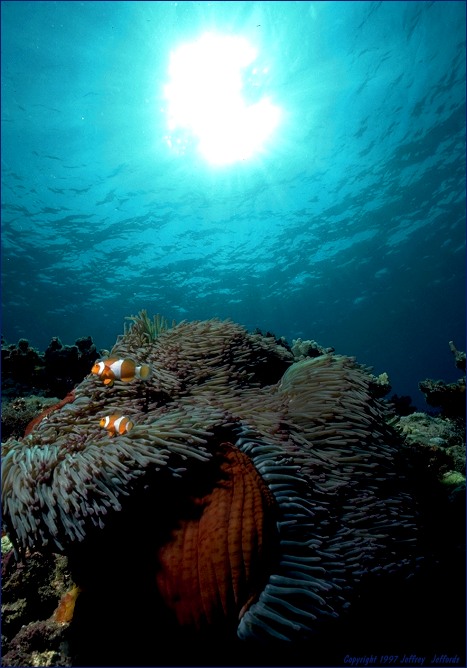| Proceed to the
Anemonefish Gallery! |
More about Anemonefish on this
site |
Anemonefish are among the most photogenic of all ocean creatures. There are known to be 28 different species of anemonefish, and over 1000 different species of sea anemone, although only 10 species of sea anemone are known to host anemonefish. They are relatively small fish, never more than a few inches in length. Anemonefish have a special symbiotic relationship with sea anemones. Normally, the nematocysts (stinging cells) of an anemone's tentacles would discharge when the fish brushed against the tentacles, paralyzing the fish. But anemonefish appear to be at home among the tentacles, even hiding among them as predators approach. There are many theories concerning the mechanism that makes this possible, but the most widely held view is that the anemonefish has a special biochemical makeup to its mucus layer that somehow provides protection from the deadly stinging cells (to the fish, but only an irritant to human skin). The photo below is of a pair of False Clown Anemonefish (Amphiprion ocellaris) with their host anemone (probably Heteractis magnifica). To the untrained eye the anemone looks like a plant, but is actually an animal that hosts unicellular algae within its tentacles and oral disc. A portion of the sugars produced by these algae during photosynthesis are consumed by the host anemone. The shallow waters of a coral reef are ideal settings for this complex relationship between algae, anemone, and anemonefish, provided the water is clear and free of pollution, allowing sunlight to reach the anemone. I returned to this particular anemone from time to time over a period of years, and
each time it was populated by anemonefish of this same species. This was an especially
good photo subject, since the anemone was in shallow water (about 17 feet on the edge of a
steep dropoff to deeper waters), and the anemonefish were especially brightly colored,
even for this species. An individual anemone may be populated by as many as seven or eight
of the same species of clownfish, often with more than one species present, but in this
case there were only three or four anemonefish. This could have been due to natural
reasons, but I suspect fish collectors
employing controversial and destructive fishing methods harvested most of the
anemone's other residents. |
|
 |
|
